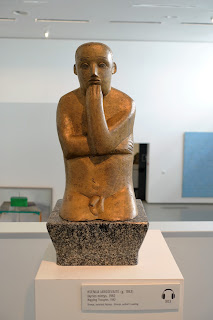Vilnius yo...
It was a pretty quiet weekend, except for my daughter, whose social calendar was taken up with a play date on Saturday afternoon and a classmate's birthday party on Sunday afternoon. If that wasn't enough, her class spent the first two nights of the ensuing school week at a recreational park outside of Vilnius, to be followed by a school picnic in the middle of the week as the term winds down on Friday. My wife and I haven't done much in comparison, with the occasional trip to a shopping mall and my daily walks (the weather didn't help - the intermittent rainfall put paid to my plans to go for a bike ride during the weekend). I wouldn't even be posting except for something I came across late last week while out for an evening stroll, a find which became relevant in light of the recent claim by the Russian ambassador to Lithuania that his country is owed $72 billion by the Lithuanians for Soviet-era investments.
As I passed by the headquarters for Lithuanian National Radio and Television on S. Konarskio gatvė, I noticed an obelisk with a small bell at the top standing out front:
There was also an explanatory sign in Lithuanian and English:
The words refer to what is known as the January Events of 1991, when the government of Soviet president Mikhail Gorbachev attempted to restore the USSR constitution in Lithuania after the Lithuanian Soviet Socialist Republic had adopted the Act of the Re-Establishment of the State of Lithuania in March 1990. A crippling economic blockade was followed starting on January 11, 1991 by the seizure of key government facilities by Soviet troops, including the capture of the building pictured above in the early hours of the 13th. Fourteen people were shot dead or crushed by tanks attempting to prevent soldiers from seizing the TV tower, located about five kilometers away from the HQ building. A crowd that eventually grew to a size of 50,000 successfully prevented troops from entering the Seimas Palace, home to the Lithuanian Supreme Council.
In the end, of course, Gorbachev's moves ended in failure. Lithuanian independence would be recognized by the Soviet Union in September 1991, and the USSR itself would cease to exist by the end of the same year. The memorial in front of the radio and television building honors not only those killed defending the TV tower, but seven customs officers executed by Soviet special police units in July 1991 in what is known as the Medininkai Incident:
The events of January 1991 were defining moments in the reestablishment of Lithuanian statehood, and they're solemnly commemorated every year. I've come across memorials at the TV tower and the Seimas parliament building, and have visited the graves of the victims at Antakalnis Cemetery. Gorbachev may be remembered in most of the Western world as the man who ended the Cold War and freed Eastern Europe (even if the end results weren't his original intentions), but his legacy in Lithuania is somewhat less respected. Any understanding of modern Lithuania must take into account of what took place on the 13th of January, 1991 in what the Lithuanians refer to as "bloody Sunday".
As for that $72 billion claim? Understandable, actually. Occupying and annexing a sovereign state, and following that up with executions and forced deportations of the populace, doesn't come cheap.
Oh, and in other news I became another year older on Wednesday. Shu-E and Amber tried to find a Lithuanian national soccer team jersey for me as a present, but couldn't track down one (national basketball team gear, on the other, is easy to locate, an indication of which sport is more popular here). So instead my wife bought an FK Žalgiris jersey, the local favorites as well as the most successful club in the top flight A lyga:
And that's all for now. Barring any unforeseen events, the three of us will be in the United Kingdom until the end of this month, so expect to see a few pics from that trip on these pages early in July.
Until then, I leave you with a few random photos taken on my walks around town:
The Vilnius District Prosecutor's Office, looking like it's covered in Band-Aids
On the Neris river
The Vilnius Palace of Concerts and Sports, a Soviet-era legacy opened in 1971 and mercifully left unused since 2004
A heavily filtered photo of a shuttered house on Vytauto gatvė






























































